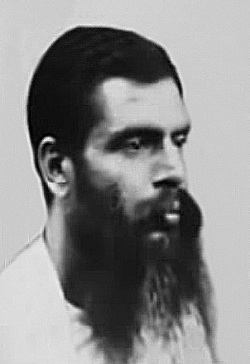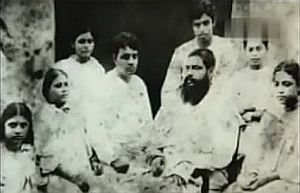Upendrakishore Ray Chowdhury facts for kids
Quick facts for kids
Upendrakishore Ray Chowdhury
|
|
|---|---|

Upendrakishore Ray Chowdhury
|
|
| Born | 12 May 1863 |
| Died | 20 December 1915 (aged 52) |
| Nationality | Indian |
| Known for | Writer, painter |
| Spouse(s) | Bidhumukhi Devi(Daughter of Dwarkanath Ganguly and step daughter of Kadambini Ganguly) |
| Children | Sukhalata Ray
Sukumar Ray Punyalata Ray Subinoy Ray Shantilata Ray Subimol Ray |
Upendrakishore Ray Chowdhury (born Kamadaranjan Ray on May 12, 1863 – died December 20, 1915) was a talented Bengali writer and painter. He was married to the daughter of Dwarkanath Ganguly.
Contents
Life Story of Upendrakishore
Upendrakishore Ray Chowdhury was born on May 12, 1863. His birthplace was a small village called Moshua. This village is in the Kishoreganj District of what is now Bangladesh. He spent most of his adult life in Kolkata, India. He passed away there on December 20, 1915, when he was only fifty-two years old.
His birth name was Kamadaranjan Ray. His father, Kalinath Ray, was a very smart scholar. He knew Sanskrit, Arabic, and Persian language. When Kamadaranjan was five, he was adopted by Harikishore. Harikishore was a family relative and a rich landowner. He renamed his adopted son Upendrakishore Roychowdhury. He also added 'Raychaudhuri' to his name as a special title.
Upendrakishore finished his Entrance exam in 1880. He even won a scholarship from Mymensingh Zilla School. He later studied at Presidency College and then at Calcutta Metropolitan Institution. He earned his BA degree in 1884. Upendra loved drawing from his school days. His first story was published in a magazine called Sakha in 1883.
His father, Kalinath Ray, was good at English and Persian. He also knew about both Indian and British legal systems. He became an expert in understanding old land documents written in Persian. This helped landowners get fair deals from the new British legal system. He became very wealthy. His family even owned two elephants.
Becoming a Printer and Publisher
Upendrakishore was the first person in South Asia to use modern blockmaking. This included making half-tone and color blocks. He was not happy with the quality of pictures in his book, Chheleder Ramayan. The pictures were made using old woodcut methods. So, he ordered books, chemicals, and equipment from Britain. He wanted to learn how to make better blocks.
After learning this skill, he started his own business in 1895. It was called U. Ray & Sons. He made blocks at his home and workplace. He tried new ways to make advanced blocks. He even wrote articles about blockmaking for a British book called Penrose Annual Volumes. A printing expert from another country once said that Upendrakishore's work was more original than others. This was surprising because he was far from the main centers of printing.
He also started publishing books. At first, other companies printed his books. From 1901 to 1914, his home and business were at 22, Sukeas Street. His famous magazine, Sandesh, was first published here in 1913.
In 1914, he opened a printing press that was one of the best in South Asia. It was also called U. Ray and Sons. He even designed the building himself. He quickly became known for his new ways of printing photos. He could print both black and white and color pictures with amazing detail. His son, Sukumar Ray, even studied printing technology in England. He did this to help run the family business.
Amazing Inventions in Printing
Upendrakishore experimented a lot with making advanced blocks. He wrote several technical articles about blockmaking. These were published in the Penrose Annual Volumes from Britain. A printing expert from another country once said that Upendrakishore's ideas were very original. This was amazing because he was so far from the main printing centers.
He invented several new methods for making halftone blocks. One of his inventions was a "screen-adjusting machine." This machine helped process cameras focus automatically. It was even built in England based on his design. The British printing handbook, the Penrose Annual, wrote about him in 1904–05. They said he had a "mathematical quality of mind." They also said his printing ideas helped operators do good work with great detail. In 1905–06, the Penrose Annual published his paper. It was about a new way to use 60-degree screens in halftone blockmaking.
A Gifted Author
Cheleder Ramayana was Upendrakishore Roychowdhury's first book. In 1883, he joined the Brahmo Samaj, a liberal religious movement. He was a very religious person. But he also loved science. This is clear from the many science articles he wrote for children.
He published two wonderful books about popular science. They became classics in the Bengali language. Sekaler Katha told the story of Earth's history. It also described ancient animals like dinosaurs. Akasher Katha was an exciting book about astronomy. His interest in science grew because of his close friends. These friends were famous scientists Jagadish Chandra Bose and Prafulla Chandra Ray. They all lived and worked near each other. He also published a well-known collection of children's stories called Tuntunir Boi.
Upendrakishore was also a musician. He wrote two books about music in Bengali. Sohaj Behala Shikkha was about learning to play the violin. Sikhak Batorike Harmonium taught how to play the harmonium with Indian music. These books were published by Dwarkin & Son. This was a famous music company started by Dwarkanath Ghose. He invented the hand-harmonium. Upendrakishore even came up with the name for the company in 1875.
His Children
Upendrakishore's oldest daughter was Shukhalata Rao. She became a social worker. She also wrote books for children and edited a newspaper called Alok. She started groups to help children and mothers. She also helped women in Orissa.
His oldest son was the famous Sukumar Ray. His second daughter was Punyalata Chakraborty. His second son was Subinoy Ray, and his youngest son was Subimal Ray.



